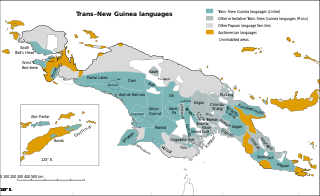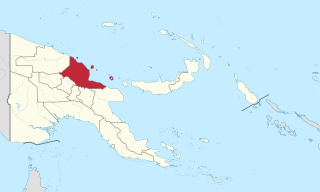Related Research Articles

Trans–New Guinea (TNG) is an extensive family of Papuan languages spoken in New Guinea and neighboring islands, perhaps the third-largest language family in the world by number of languages. The core of the family is considered to be established, but its boundaries and overall membership are uncertain. The languages are spoken by around 3 million people. There have been three main proposals as to its internal classification.
Indo-Pacific is a hypothetical language macrofamily proposed in 1971 by Joseph Greenberg and now believed to be spurious. It grouped together the Papuan languages of New Guinea and Melanesia with the languages of the Andaman Islands and, tentatively, the languages of Tasmania, both of which are remote from New Guinea. The valid cognates Greenberg found turned out to be reflexes of the less extensive Trans–New Guinea family. Recently the Kusunda language, which is generally seen as a language isolate, is also included in the Indo-Pacific proposal.

Madang is a province of Papua New Guinea. The province is on the northern coast of mainland Papua New Guinea and has many of the country's highest peaks, active volcanoes and its biggest mix of languages. The capital is the town of Madang.
The Piawi languages are a small family of Papuan languages spoken in the Schraeder Range of the Madang Highlands of Papua New Guinea that had been part of Stephen Wurm's Trans–New Guinea proposal. They are now connected to the Arafundi and Madang languages.
The Numugen (Numagen) languages are a small family of closely related languages in the Madang branch of the Trans–New Guinea languages (TNG) phylum of New Guinea, spoken in the region of the Numagen River.
The Northern Adelbert or Pihom–Isumrud languages are a family of two dozen languages in the Madang stock of New Guinea. The occupy the coastal northern Adelbert Range of mountains, vs. the Southern Adelbert languages, another branch of Madang.
The Mindjim languages are a small family of closely related languages spoken in the Mindjim River area of Papua New Guinea. They were linked with the Rai Coast languages in 1951 by Arthur Capell in his Madang family, but separated out again by Timothy Usher.
The Rai Coast languages are a family of languages in the Madang stock of New Guinea.

The Madang or Madang–Adelbert Range languages are a language family of Papua New Guinea. They were classified as a branch of Trans–New Guinea by Stephen Wurm, followed by Malcolm Ross. William A. Foley concurs that it is "highly likely" that the Madang languages are part of TNG, although the pronouns, the usual basis for classification in TNG, have been "replaced" in Madang. Timothy Usher finds that Madang is closest to the Upper Yuat River languages and other families to its west, but does not for now address whether this larger group forms part of the TNG family.
The Ottilien languages are a small family of clearly related languages,

Mauwake (Mawake), or Ulingan, is a Papuan language of Madang Province, Papua New Guinea. It is spoken in several villages along the north coast of Madang province, which lies in the north-east of Papua New Guinea.
The Arafundi languages are a small family of clearly related languages in East Sepik Province, Papua New Guinea. They are related to the Piawi and Madang languages. They are named after the Arafundi River.
The Middle Ramu or Annaberg languages are a small language family of Madang Province, Papua New Guinea. It is no longer accepted as a valid grouping by Glottolog, but is accepted by Foley (2018).
The Tamolan languages are a small family of clearly related languages spoken in the region of the Guam River in Madang Province, Papua New Guinea.
Dumun is an endangered Madang language spoken in Madang Province, Papua New Guinea.
The South Adelbert or Southern Adelbert Range languages are a family of languages in the Madang stock of New Guinea, spoken along the tributaries of the Ramu River in the watershed of the Adelbert Range.
The Upper Yuat languages consist of two small language families, namely Arafundi and Piawi, spoken in the region of the upper Yuat River of New Guinea. The connection was first suggested by William A. Foley and confirmed by Timothy Usher, who further links them to the Madang languages.
The Sogeram languages are a family of languages in the Madang stock of New Guinea. They are named after the Sogeram River.
The Porapora languages are a pair of closely related languages in the Ramu language family, Gorovu and Adjora (Abu), spoken along the border of East Sepik Province and Madang Province in Papua New Guinea. Foley classifies them as part of the Grass group of languages, but Usher break up the Grass languages. Foley (2018) included Aion (Ambakich) as well, but it has since been shown to be one of the Keram languages.
Proto-Trans–New Guinea is the reconstructed proto-language ancestral to the Trans–New Guinea languages. Reconstructions have been proposed by Malcolm Ross and Andrew Pawley.
References
- ↑ Hammarström, Harald; Forkel, Robert; Haspelmath, Martin, eds. (2017). "Yaganon". Glottolog 3.0 . Jena, Germany: Max Planck Institute for the Science of Human History.
- 1 2 New Guinea World, Yaganon River
- ↑ Dumun at Ethnologue (22nd ed., 2019)